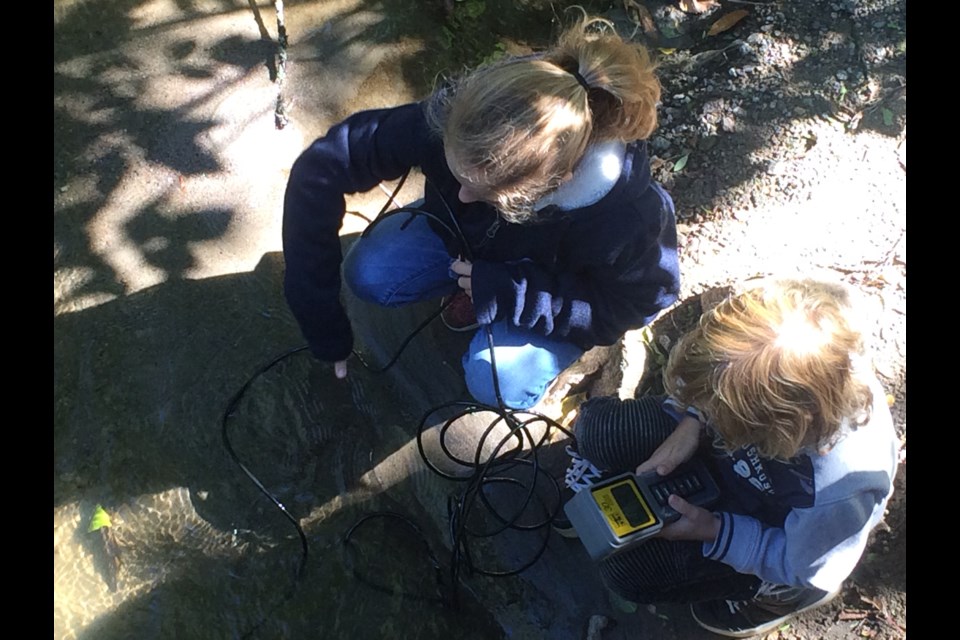Chippewa Creek weaves it way through the City of North Bay from the escarpment emptying into Lake Nipissing.
Just last weekend, over 500 trees and shrubs were planted along a section of the creek to help reduce erosion and protect the creek.
See:Protecting Chippewa Creek by planting hundreds of trees and shrubs
Over the years, community groups and individuals have participated in the Adopt-the-Creek program, committed to maintaining and restoring the creek along their section of the EcoPath.
Meghan Walsh and her children Elora and Sebastian do their bit to help preserve the natural beauty of the creek.
“We adopted a part of the creek about three years ago, with one of my girlfriends, it was something to do to involve the kids, so we go down all the time to make sure the creek is clean, and check it out and explore around.”
The family returned to the creek Saturday to participate in the inaugural Chippewa Creek EcoPath Festival organized by the North Bay-Mattawa Conservation Authority.
“It’s been great fun for the kids. They’re learning about identifying species, and water turbidity. We actually collected water last year every second week during the summer for the conservation authority to check out the creek. So this is good fun to learn what happens on the other end of things.”
Roughly a dozen information booths were set up by community partners running along the EcoPath from Thomson Park to Hammond Street.
“Each booth has an activity or something people can take home with them to remember from their adventure, and at the same time, they get to learn about the creek, and celebrate the creek,” explained Paula Loranger Community relations coordinator for the North Bay-Mattawa Conservation Authority.
Some of the stops included nature identification, painting folk art on rocks or wood, water quality analysis, planting shrubs, teachings and story telling from the North Bay Indigenous Friendship Centre, and making bee hotels to take home.
Ellen Perry is a co-op student on placement at Nipissing University, which was one of the community partners taking part in the festival.
The festival gave her an opportunity to talk to people and get some insight into the work they do as she considers enrolling in a post-secondary environmental studies program.
“I thought the Canadore booth was really cool because they were doing water testing and that’s really fun to learn about. And Nipissing was talking about the different species and stuff like that, and that’s really important because it’s our ecosystem and it’s cool to try and identify them. I’m really enjoying all this,” said Perry.
Marnie McKenney brought her two young grandchildren
“We had never walked along this section off Fisher Street before, and I thought it would be interesting for them. They liked the activities and getting their passports stamped at the different booths. It was fun for them,” said McKenney.
“They liked the Canadore display because there were instruments and buttons they could push, and things they could do. They like the robotics team at the very beginning. They liked the hands-on things. They also got seeds from the Heritage Gardeners to take home and plant from plants they harvested and took the seeds from at the waterfront. Things like that are wonderful giveaways. Personally, I learned how lovely this section of the path is. We’re so lucky in North Bay with the resources we have.”
Braunwyn McKenney got right down to creek level with her little brother Wylde and a Canadore student testing the water.
“We were testing the water to see if it was acidic. We used two different machines and we put them in the water to see what the numbers were. The numbers showed it was pretty good water. It was a lot of fun. We got to learn a whole bunch of different stuff.”
While Wylde enjoyed the water sampling process, other things along the EcoPath caught his attention.
“I saw a little bird in a tree. I am looking for birds on my walk. I like that eagles have one of my favourite shades, white on its head. I’m looking for eagles, but I haven’t seen one yet,” said the eight-year-old.
At his booth, volunteer Jacob Szaranski helped dozens of people make bird feeders out of pine cones.
“The kids have been covering the pine cones in margarine and bird seed from a bird seed mix we bought. It’s very quick to do and will last a few days. The kids can even do it at home. Here they would probably attract chickadees.”
Studying to become an environmental technician, Ken Garit thought the festival was informative.
“It gives people an idea of what we’re trying to do with the environment. It’s very important that we stay on top of things because the environment is important to us, so we’re trying to help it stay healthy. And the festival teaches kids some of the ways to do that.”



